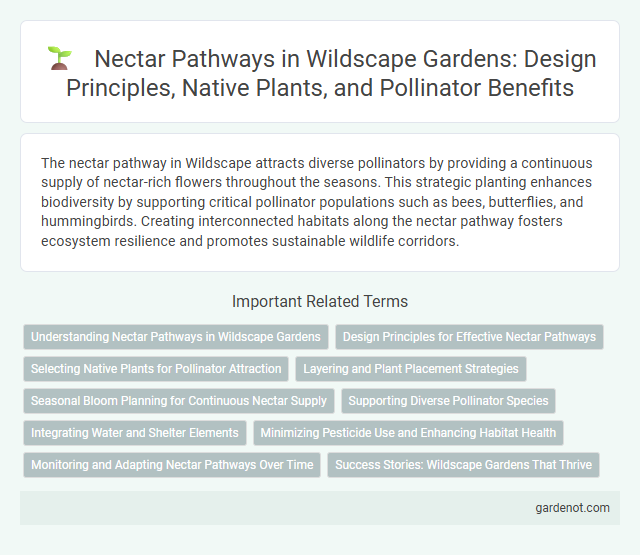The nectar pathway in Wildscape attracts diverse pollinators by providing a continuous supply of nectar-rich flowers throughout the seasons. This strategic planting enhances biodiversity by supporting critical pollinator populations such as bees, butterflies, and hummingbirds. Creating interconnected habitats along the nectar pathway fosters ecosystem resilience and promotes sustainable wildlife corridors.
Understanding Nectar Pathways in Wildscape Gardens
Nectar pathways in Wildscape Gardens serve as vital corridors that facilitate pollinator movement, enhancing biodiversity and plant reproduction. These pathways are designed with native, nectar-rich flowering plants that bloom sequentially to provide continuous food sources for bees, butterflies, and hummingbirds. Understanding and preserving these nectar pathways helps maintain ecological balance and supports the sustainability of local wildlife populations.
Design Principles for Effective Nectar Pathways
Effective nectar pathways prioritize continuous flowering plants to ensure consistent nectar availability for pollinators. Incorporating native species adapted to local climates enhances pollinator attraction and supports biodiversity. Strategic layering of plant heights and colors maximizes visibility and accessibility, promoting efficient pollinator movement and feeding.
Selecting Native Plants for Pollinator Attraction
Selecting native plants for the nectar pathway enhances pollinator attraction by providing essential food sources tailored to local species. Native plants like coneflowers, milkweed, and bee balm offer high nectar quantities that support bees, butterflies, and hummingbirds. Incorporating diverse bloom times ensures a continuous nectar supply, promoting robust pollinator populations throughout the growing season.
Layering and Plant Placement Strategies
Effective layering in the Nectar Pathway enhances pollinator access by strategically placing native wildflowers, shrubs, and ground covers to create vertical complexity. Positioning early-blooming plants in the lower strata encourages early-season pollinators while taller flowering shrubs provide resources for late-season species. This plant placement strategy maximizes nectar availability throughout the growing season, supporting diverse pollinator populations in the Wildscape environment.
Seasonal Bloom Planning for Continuous Nectar Supply
Seasonal Bloom Planning in Wildscape's Nectar Pathway ensures a continuous nectar supply by strategically selecting plant species with staggered flowering periods. This approach enhances pollinator support throughout the year by maintaining consistent nectar availability. By integrating diverse native flora adapted to local climate cycles, the pathway promotes ecological balance and sustained biodiversity.
Supporting Diverse Pollinator Species
Nectar pathways are crucial habitats supporting diverse pollinator species by providing continuous nectar sources throughout the growing season. They facilitate foraging efficiency for bees, butterflies, and hummingbirds, enhancing pollination success in wildscapes. Establishing native flowering plants in nectar pathways promotes ecosystem resilience and biodiversity conservation.
Integrating Water and Shelter Elements
The Nectar Pathway in Wildscape enhances biodiversity by seamlessly integrating water features and shelter elements, creating vital habitats for pollinators and wildlife. Carefully designed ponds and shaded resting areas support nectar-producing plants, maximizing ecological balance and species interaction. This integration fosters a sustainable environment crucial for sustaining local ecosystems.
Minimizing Pesticide Use and Enhancing Habitat Health
Nectar pathways play a crucial role in minimizing pesticide use by fostering natural pollinator populations that reduce the need for chemical interventions. Enhancing habitat health through diverse native flowering plants supports beneficial insects, promoting ecosystem balance and resilience. This integrated approach leads to sustainable agricultural practices and improved biodiversity within Wildscape environments.
Monitoring and Adapting Nectar Pathways Over Time
Monitoring nectar pathways over time in Wildscape ensures the preservation of critical pollinator routes and floral biodiversity. Utilizing GPS tracking, remote sensing, and field surveys enables adaptive management to address habitat changes, invasive species, and climate impacts. Data-driven adjustments to planting strategies and habitat restoration optimize nectar availability, supporting pollinator populations and ecosystem resilience.
Success Stories: Wildscape Gardens That Thrive
Wildscape gardens that thrive showcase the effectiveness of nectar pathways in supporting pollinator populations and enhancing biodiversity. These success stories include increased sightings of native bees, butterflies, and hummingbirds, which contribute to healthier ecosystems and improved plant reproduction rates. Optimized nectar source diversity and seasonal bloom continuity are key factors driving the sustainability and vibrancy of these thriving wildscape gardens.
Nectar pathway Infographic

 gardenot.com
gardenot.com